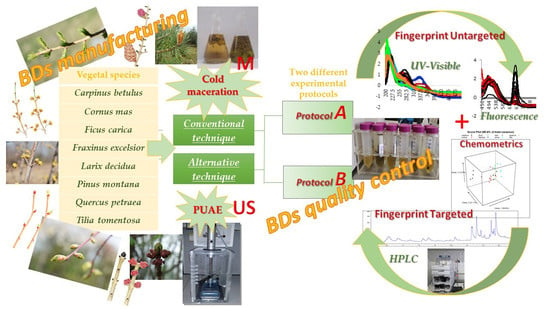Bud-Derivatives, a Novel Source of Polyphenols and How Different Extraction Processes Affect Their Composition
Abstract
1. Introduction
2. Materials and Methods
2.1. Raw Samples
2.2. Chemicals
2.3. Bud-Derivatives Manufacturing Applying Two Different Methods
2.3.1. Conventional Cold Maceration (M) as Traditional Method
- (A)
- A 21 days maceration of buds in glycerol/ethanol 96% (1/1 w/w) with a 1:20 bud/solvent ratio (considering the dry weight) has been performed, according to the official method of glyceric macerates reported in the European Pharmacopoeia VIII edition [9] (“M_A”).
- (B)
- A 3 months maceration of buds in a mixture of water/glycerol/ethanol 96% (50/20/30 w/w/w) as extraction solvent with a bud/solvent ratio variable (considering the fresh weight) depending on the botanical species (see Table 2) has been used, according to the method optimized and used by the Company to produce glyceric macerates (“M_B”).
2.3.2. Green Extraction: Pulsed Ultrasound-Assisted Extraction (US) as Alternative Method
2.4. Spectroscopic Analysis: UV-Visible Fingerprint
2.5. HPLC Analysis
2.6. Data Analysis
2.6.1. Chemometric Analysis
2.6.2. Data Matrices Organization
3. Results and Discussion
3.1. Bud-Derivatives Identification: UV-Visible Fingerprint
3.2. Bud-Derivatives Identification: UV-Visible and HPLC Fingerprints
3.3. Phenolic Composition of BDs
4. Conclusions
Supplementary Materials
Author Contributions
Funding
Acknowledgments
Conflicts of Interest
References
- Czepielewska, E.; Makarewicz-Wujec, M.; Różewski, F.; Wojtasik, E. Kozłowska-Wojciechowska, M. Drug adulteration of food supplements: A threat to public health in the European Union? Regul. Toxicol. Pharmacol. 2018, 97, 98–102. [Google Scholar] [CrossRef]
- Italian Ministry of Health. Available online: http://www.salute.gov.it/portale/temi/p2_5.jsp?lingua=italiano&area=Alimentiparticolarieintegratori&menu=integratori (accessed on 20 March 2020).
- European Commission. Food Supplements. Available online: https://ec.europa.eu/food/safety/labelling_nutrition/supplements_en (accessed on 21 May 2020).
- Colombo, F.; Restani, P.; Biella, S.; Di Lorenzo, C. Botanicals in Functional Foods and Food Supplements: Tradition, Efficacy and Regulatory Aspects. Appl. Sci. 2020, 10, 2387. [Google Scholar] [CrossRef]
- Restani, P.; Di Lorenzo, C.; Garcia-Alvarez, A.; Frigerio, G.; Colombo, F.; Maggi, F.M.; Milà-Villarroel, R.; Serra-Majem, L. The PlantLIBRA consumer survey: Findings on the use of plant food supplements in Italy. PLoS ONE 2018, 13, e0190915. [Google Scholar] [CrossRef]
- Deconinck, E.; Vanhamme, M.; Bothy, J.L.; Courselle, P. A strategy based on fingerprinting and chemometrics for the detection of regulated plants in plant food supplements from the Belgian market: Two case studies. J. Pharm. Biomed. Anal. 2019, 166, 189–196. [Google Scholar] [CrossRef]
- Fibigr, J.; Šatínský, D.; Solich, P. Current trends in the analysis and quality control of food supplements based on plant extracts. Anal. Chim. Acta 2018, 1036, 1–15. [Google Scholar] [CrossRef]
- FINNOVER Interreg Alcotra Project 2017–2020. Available online: http://www.interreg-finnover.com/ (accessed on 20 May 2020).
- Pharmacopée Française. Codex Medicamentarius Gallicus, Codex Français: Monographie, Préparations Homéopathiques; Ordre National des Pharmaciens: Paris, France, 1965; Available online: http://ansm.sante.fr/Mediatheque/Publications/Pharmacopee-francaise-Plan-Preambule-index (accessed on 21 May 2020).
- Turrini, F.; Donno, D.; Boggia, R.; Beccaro, G.L.; Zunin, P.; Leardi, R.; Pittaluga, A.M. An innovative green extraction and re-use strategy to valorize food supplement by-products: Castanea sativa bud preparations as case study. Food Res. Int. 2019, 115, 276–282. [Google Scholar] [CrossRef]
- Turrini, F.; Donno, D.; Beccaro, G.L.; Zunin, P.; Pittaluga, A.; Boggia, R. Pulsed Ultrasound-Assisted Extraction as an Alternative Method to Conventional Maceration for the Extraction of the Polyphenolic Fraction of Ribes nigrum Buds: A New Category of Food Supplements Proposed by The FINNOVER Project. Foods 2019, 8, 466. [Google Scholar] [CrossRef]
- Allio, A.; Calorio, C.; Franchino, C.; Gavello, D.; Carbone, E.; Marcantoni, A. Bud extracts from Tilia tomentosa Moench inhibit hippocampal neuronal firing through GABAA and benzodiazepine receptors activation. J. Ethnopharmacol. 2015, 172, 288–296. [Google Scholar] [CrossRef]
- Calorio, C.; Donno, D.; Franchino, C.; Carabelli, V.; Marcantoni, A. Bud extracts from Salix caprea L. inhibit voltage gated calcium channels and catecholamines secretion in mouse chromaffin cells. Phytomedicine 2017, 36, 168–175. [Google Scholar] [CrossRef]
- Nervo, T.; Bergamini, L.; Guido, M.; Ferraro, F. Composizione e Relativo Uso Nel Trattamento Dell’endometrite Animale. U.S. Patent n. TO2015A000193, 2 April 2015. [Google Scholar]
- Olivero, G.; Turrini, F.; Vergassola, M.; Boggia, R.; Zunin, P.; Donno, D.; Beccaro, G.L.; Grilli, M.; Pittaluga, A. The 3Rs: Reduction and refinement through a multivariate statistical analysis approach in a behavioural study tounveil anxiolytic effects of natural extracts of Tilia tomentosa. Biomed. Sci. Eng. 2019, 3, 116. [Google Scholar] [CrossRef][Green Version]
- Antonaci, I. Effetto Di Un Trattamento Fitoterapico Su Alcuni Parametri Ematologici Dell’asina Da Latte. Bachelor’s Thesis, Degree-granting Produzioni e Gestione degli Animali in Allevamento e Selvatici University of Turin, Turin, Italy, 2017. [Google Scholar]
- Guerra, C.; Nury, C. Utilizzo Di Una Soluzione Fitoterapica Per Un Trattamento Alternativo Dell’endometrite Equina. Bachelor’s Thesis, Degree-Granting Medicina Veterinaria University of Turin, Turin, Italy, 2015. [Google Scholar]
- Donno, D.; Beccaro, G.L.; Cerutti, A.K.; Mellano, M.G.; Bounous, G. Bud Extracts as New Phytochemical Source for Herbal Preparations-Quality Control and Standardization by Analytical Fingerprint. In Phytochemicals—Isolation, Characterisation and Role in Human Health, 1st ed.; Rao, A.V., Rao, L.G., Eds.; InTech: Rijeka, Croatia, 2015; pp. 187–218. [Google Scholar] [CrossRef]
- Donno, D.; Mellano, M.G.; Cerutti, A.K.; Beccaro, G.L. Biomolecules and Natural Medicine Preparations: Analysis of New Sources of Bioactive Compounds from Ribes and Rubus spp. Buds. Pharmaceuticals 2016, 9, 7. [Google Scholar] [CrossRef]
- Sanzini, E.; Badea, M.; Dos Santos, A.; Restani, P.; Sievers, H. Quality control of plant food supplements. Food Funct. 2011, 2, 740–746. [Google Scholar] [CrossRef]
- Donno, D.; Boggia, R.; Zunin, P.; Cerutti, A.K.; Guido, M.; Mellano, M.G.; Prgomet, Z.; Beccaro, G.L. Phytochemical fingerprint and chemometrics for natural food preparation pattern recognition: An innovative technique in food supplement quality control. J. Food Sci. Technol. 2016, 53, 1071–1083. [Google Scholar] [CrossRef]
- Directive 2002/46/EC of the European Parliament and of the Council of 10 June 2002 on the Approximation of the Laws of the Member States Relating to Food Supplements. Available online: https://eur-lex.europa.eu/eli/dir/2002/46/2017-07-26 (accessed on 5 September 2020).
- Decreto Legislativo 21 Maggio 2004, n.169, Attuazione Della Direttiva 2002/46/CE Relativa Agli Integratori Alimentari. Available online: https://www.gazzettaufficiale.it/eli/id/2004/07/15/004G0201/sg (accessed on 5 September 2020).
- European Federation of Associations of Health Product Manufacturers (EHPM). Available online: https://www.ehpm.org/attachments/article/117/EHPM%20Quality%20Guide%20101214.pdf (accessed on 5 September 2020).
- Watson, R.R. Polyphenols in Plants: Isolation, Purification and Extract Preparation, 2nd ed.; Academic Press: London, UK, 2018. [Google Scholar]
- Ma, G.; Chen, Y. Polyphenol supplementation benefits human health via gut microbiota: A systematic review via meta-analysis. J. Funct. Foods 2020, 66, 103829. [Google Scholar] [CrossRef]
- Tsao, R. Chemistry and biochemistry of dietary polyphenols. Nutrients 2010, 2, 1231–1246. [Google Scholar] [CrossRef]
- Tresserra-Rimbau, A.; Rimm, E.B.; Medina-Remón, A.; Martínez-González, M.A.; de la Torre, R.; Corella, D.; Salas-Salvadó, J.; Gómez-Gracia, E.; Lapetra, J.; Arós, F.; et al. Inverse association between habitual polyphenol intake and incidence of cardiovascular events in the PREDIMED study. Nutr. Metab. Cardiovasc. Dis. 2014, 24, 639–647. [Google Scholar] [CrossRef]
- Kwok, C.S.; Boekholdt, S.M.; Lentjes, M.A.H.; Loke, Y.K.; Luben, R.N.; Yeong, J.K.; Wareham, N.J.; Myint, P.K.; Khaw, K.T. Habitual chocolate consumption and risk of cardiovascular disease among healthy men and women. Heart 2015, 101, 1279–1287. [Google Scholar] [CrossRef]
- Wang, P.Y.; Fang, J.C.; Gao, Z.H.; Zhang, C.; Xie, S.Y. Higher intake of fruits, vegetables or their fiber reduces the risk of type 2 diabetes: A meta-analysis. J. Diabetes Investig. 2016, 7, 56–69. [Google Scholar] [CrossRef]
- Wang, S.; Moustaid-Moussa, N.; Chen, L.; Mo, H.; Shastri, A.; Su, R.; Bapat, P.; Kwun, I.; Shen, C.L. Novel insights of dietary polyphenols and obesity. J. Nutr. Biochem. 2014, 25, 1–18. [Google Scholar] [CrossRef]
- Serra, D.; Almeida, L.M.; Dinis, T.C.P. Dietary polyphenols: A novel strategy to modulate microbiota-gut-brain axis. Trends Food Sci. Technol. 2018, 78, 224–233. [Google Scholar] [CrossRef]
- Vauzour, D. Dietary polyphenols as modulators of brain functions: Biological actions and molecular mechanisms underpinning their beneficial effects. Oxidative Med. Cell. Longev. 2012, 2012, 914273. [Google Scholar] [CrossRef]
- Liu, X.; Du, X.; Han, G.; Gao, W. Association between tea consumption and risk of cognitive disorders: A dose-response meta-analysis of observational studies. Oncotarget 2017, 8, 43306–43321. [Google Scholar] [CrossRef]
- Brglez Mojzer, E.; Knez Hrnčič, M.; Škerget, M.; Knez, Ž.; Bren, U. Polyphenols: Extraction Methods, Antioxidative Action, Bioavailability and Anticarcinogenic Effects. Molecules 2016, 21, 901. [Google Scholar] [CrossRef]
- Donno, D.; Beccaro, G.L.; Mellano, M.G.; Bonvegna, L.; Bounous, G. Castanea spp. buds as a phytochemical source for herbal preparations: Botanical fingerprint for nutraceutical identification and functional food standardization. J. Sci. Food Agric. 2014, 94, 2863–2873. [Google Scholar] [CrossRef]
- Chemat, F.; Vian, M.A.; Cravotto, G. Green extraction of natural products: Concept and principles. Int. J. Mol. Sci. 2012, 13, 8615–8627. [Google Scholar] [CrossRef]
- Green Chemistry’s 12 Principles, United States Environmental Protection Agency. Available online: https://www.epa.gov/greenchemistry/basics-green-chemistry#twelve (accessed on 19 March 2020).
- Ministero Delle Politiche Agricole Alimentari E Forestali. Piano Di Settore Della Filiera Delle Piante Officinali 2014–16. Available online: https://www.politicheagricole.it/flex/cm/pages/ServeBLOB.php/L/IT/IDPagina/7562 (accessed on 21 May 2020).
- Chemat, F.; Rombaut, N.; Sicaire, A.G.; Meullemiestre, A.; Fabiano-Tixier, A.S.; Abert-Vian, M. Ultrasound assisted extraction of food and natural products. Mechanisms, techniques, combinations, protocols and applications. A review. Ultrason. Sonochem. 2017, 34, 540–560. [Google Scholar] [CrossRef]
- Vinatoru, M.; Mason, T.J.; Calinescu, I. Ultrasonically assisted extraction (UAE) and microwave assisted extraction (MAE) of functional compounds from plant materials. Trends Anal. Chem. 2017, 97, 159–178. [Google Scholar] [CrossRef]
- Vernès, L.; Vian, M.; Chemat, F. Chapter 12—Ultrasound and Microwave as Green Tools for Solid-Liquid Extraction. In Handbooks in Separation Science, Liquid-Phase Extraction, 1st ed.; Poole, C.F., Ed.; Elsevier: Amsterdam, The Netherlands, 2020; pp. 355–374. [Google Scholar] [CrossRef]
- Boggia, R.; Turrini, F.; Anselmo, M.; Zunin, P.; Donno, D.; Beccaro, G.L. Feasibility of UV-VIS-Fluorescence Spectroscopy combined with pattern recognition techniques to authenticate a new category of plant food supplements. J. Food Sci. Technol. 2017, 54, 2422–2432. [Google Scholar] [CrossRef]
- Donno, D.; Mellano, M.G.; Riondato, I.; De Biaggi, M.; Andriamaniraka, H.; Gamba, G.; Beccaro, G.L. Traditional and Unconventional Dried Fruit Snacks as a Source of Health-Promoting Compounds. Antioxidants 2019, 8, 396. [Google Scholar] [CrossRef]
- Li, A.N.; Li, S.; Zhang, Y.J.; Xu, X.R.; Chen, Y.M.; Li, H.B. Resources and Biological Activities of Natural Polyphenol. Nutrients 2014, 6, 6020–6047. [Google Scholar] [CrossRef]
- Vilkhu, K.; Mawson, R.; Simons, L.; Bates, D. Applications and opportunities for ultrasound assisted extraction in the food industry—A review. Innov. Food Sci. Emerg. Technol. 2008, 9, 161–169. [Google Scholar] [CrossRef]
- Pan, Z.; Qu, W.; Ma, H.; Atungulu, G.G.; McHugh, T.H. Continuous and pulsed ultrasound-assisted extractions of antioxidants from pomegranate peel. Ultrason. Sonochem. 2011, 18, 1249–1257. [Google Scholar] [CrossRef]
- Mok, D.K.W.; Chau, F.T. Chemical information of Chinese medicines: A challenge to chemist. Chemom. Intell. Lab. Syst. 2006, 82, 210–217. [Google Scholar] [CrossRef]
- Italian Chemical Society. Division of Analytical Chemistry-Group of Chemometrics. CAT Chemometric Agile Tool. Available online: http://www.gruppochemiometria.it/index.php/software (accessed on 25 May 2020).
- Wold, S.; Esbensen, K.; Geladi, P. Principal Component Analysis. Chemom. Intell. Lab. Syst. 1987, 2, 37–52. [Google Scholar] [CrossRef]
- Jolliffe, I.T. Principal Component Analysis, 2nd ed.; Springer Series in Statistics; Springer: New York, NY, USA, 2002. [Google Scholar]
- Barnes, R.J.; Dhanoa, M.S.; Lister, S.J. Standard normal variate transformation and de-trending of near-infrared diffuse reflectance spectra. Appl. Spectrosc. 1989, 43, 772–777. [Google Scholar] [CrossRef]
- Oliveri, P. Class-modelling in food analytical chemistry: Development, sampling, optimisation an validation issues—A tutorial. Anal. Chim. Acta 2017, 982, 9–19. [Google Scholar] [CrossRef]
- Wold, S.; Johansson, E.; Cocchi, M. 3D QSAR in Drug Design: Theory, Methods and Applications; Hugo, K., Ed.; ESCOM Science Publishers: Leiden, The Netherlands, 1993; p. 523. [Google Scholar]
- Chemat, F.; Ashokkumar, M. Preface: Ultrasound in the processing of liquid foods, beverages and alcoholic drinks. Ultrason. Sonochem. 2017, 38, 753. [Google Scholar] [CrossRef]
- Paniwnyk, L. Applications of ultrasound in processing of liquid foods: A review. Ultrason. Sonochem. 2017, 38, 794–806. [Google Scholar] [CrossRef]
- Falcão, L.; Araújo, M.E.M. Vegetable Tannins Used in the Manufacture of Historic Leathers. Molecules 2018, 23, 1081. [Google Scholar] [CrossRef]
- Okuda, T.; Yoshida, T.; Hatano, T.; Iwasaki, M.; Kubo, M.; Orime, T.; Yoshizaki, M.; Naruhashi, N. Hydrolysable tannins as chemotaxonomic markers in the rosaceae. Phytochemistry 1992, 31, 3091–3096. [Google Scholar] [CrossRef]
- Yoshida, T.; Amakura, Y.; Yoshimura, M. Structural features and biological properties of ellagitannins in some plant families of the order Myrtales. Int. J. Mol. Sci. 2010, 11, 79–106. [Google Scholar] [CrossRef]
- Moilanen, J.; Koskinen, P.; Salminen, J.P. Distribution and content of ellagitannins in Finnish plant species. Phytochemistry 2015, 116, 188–197. [Google Scholar] [CrossRef]
- Rocha, L.D.; Monteiro, M.C.; Teodoro, A.J. Anticancer properties of hydroxycinnamic acids—A Review. Cancer Clin. Oncol. 2012, 1, 109–121. [Google Scholar] [CrossRef]
- Zelber-Sagi, S.; Salomone, F.; Mlynarsky, L. The Mediterranean dietary pattern as the diet of choice for non-alcoholic fatty liver disease: Evidence and plausible mechanisms. Liver Int. 2017, 37, 936–949. [Google Scholar] [CrossRef]
- Brereton, R.G. Applied Chemometrics for Scientists; John Wiley & Sons, Ltd.: Chichester, UK, 2007. [Google Scholar] [CrossRef]
- De Biaggi, M.; Donno, D.; Mellano, M.G.; Gamba, G.; Riondato, I.; Rakotoniaina, E.N.; Beccaro, G.L. Emerging species with nutraceutical properties: Bioactive compounds from Hovenia dulcis pseudofruits. Food Chem. 2020, 310, 125816. [Google Scholar] [CrossRef]
- Kim, H.K.; Jeong, T.-S.; Lee, M.-K.; Park, Y.B.; Choi, M.-S. Lipid-lowering efficacy of hesperetin metabolites in high-cholesterol fed rats. Clin. Chim. Acta 2003, 327, 129–137. [Google Scholar] [CrossRef]
- Li, F.; Li, S.; Li, H.-B.; Deng, G.-F.; Ling, W.-H.; Wu, S.; Xu, X.-R.; Chen, F. Antiproliferative activity of peels, pulps and seeds of 61 fruits. J. Funct. Foods 2013, 5, 1298–1309. [Google Scholar] [CrossRef]
- Beccaro, G.L.; Donno, G.; Lione, G.G.; De Biaggi, M.; Gamba, G.; Rapalino, S.; Riondato, I.; Gonthier, P.; Mellano, M.M. Castanea spp. Agrobiodiversity Conservation: Genotype Influence on Chemical and Sensorial Traits of Cultivars Grown on the Same Clonal Rootstock. Foods 2020, 9, 1062. [Google Scholar] [CrossRef]
- Alfei, S.; Signorello, M.G.; Schito, A.; Catena, S.; Turrini, F. Reshaped as polyester-based nanoparticles, gallic acid inhibits platelet aggregation, reactive oxygen species production and multi-resistant Gram-positive bacteria with an efficiency never obtained. Nanoscale Adv. 2019, 1, 4148–4157. [Google Scholar] [CrossRef]
- Alfei, S.; Turrini, F.; Catena, S.; Zunin, P.; Grilli, M.; Pittaluga, A.M.; Boggia, R. Ellagic acid a multi-target bioactive compound for drug discovery in CNS? A narrative review. Eur. J. Med. Chem. 2019, 183, 111724. [Google Scholar] [CrossRef]
- Ananingsih, V.K.; Sharma, A.; Zhou, W. Green tea catechins during food processing and storage: A review on stability and detection. Food Res. Int. 2013, 50, 469–479. [Google Scholar] [CrossRef]
- Franco, D.; Sineiro, J.; Rubilar, M.; Sánchez, M.; Jerez, M.; Pinelo, M.; Costoya, N.; Núñez, M.J. Polyphenols from plant materials: Extraction and antioxidant power. Electron. J. Environ. Agric. Food Chem. 2008, 7, 3210–3216. [Google Scholar]
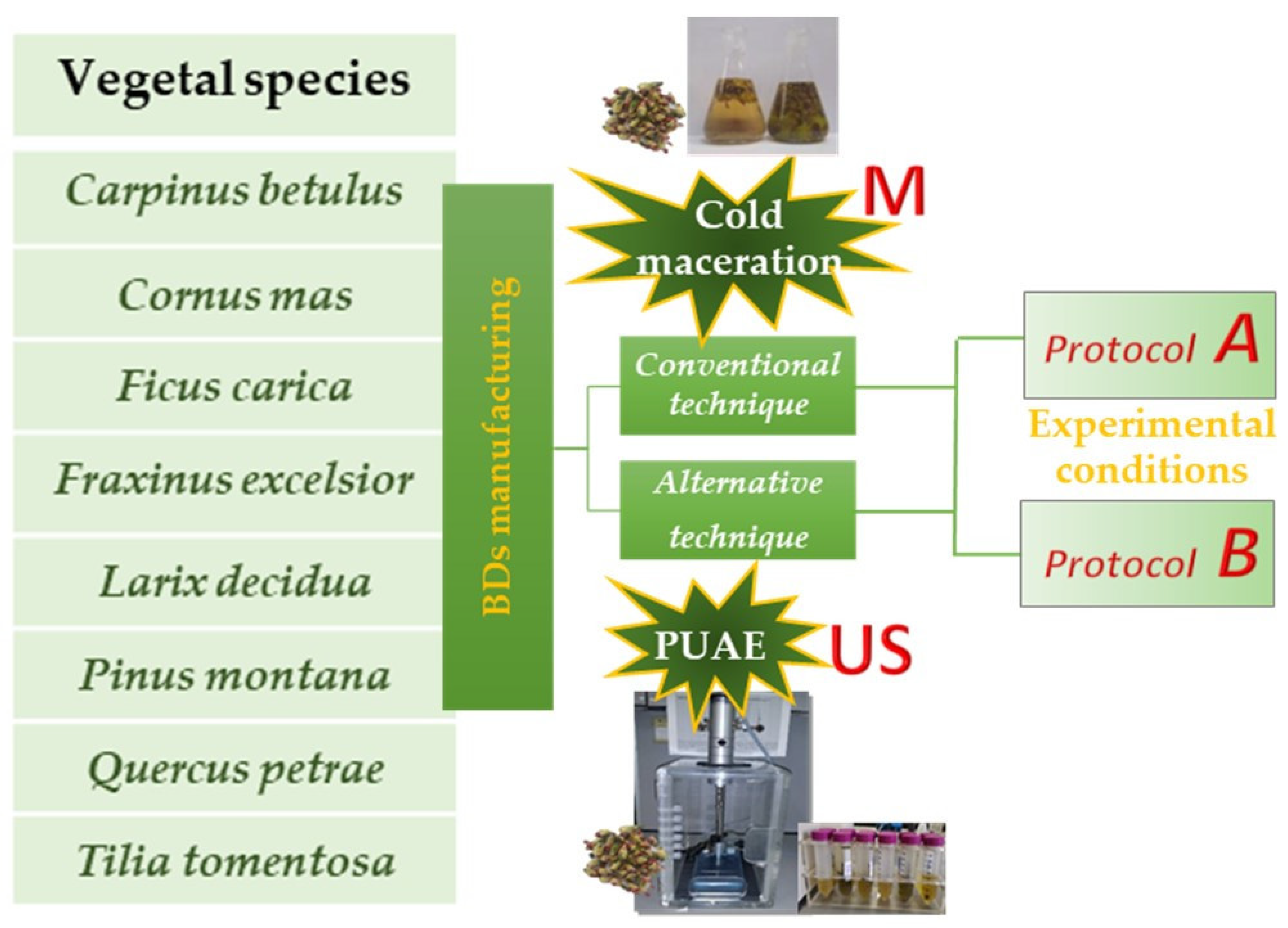

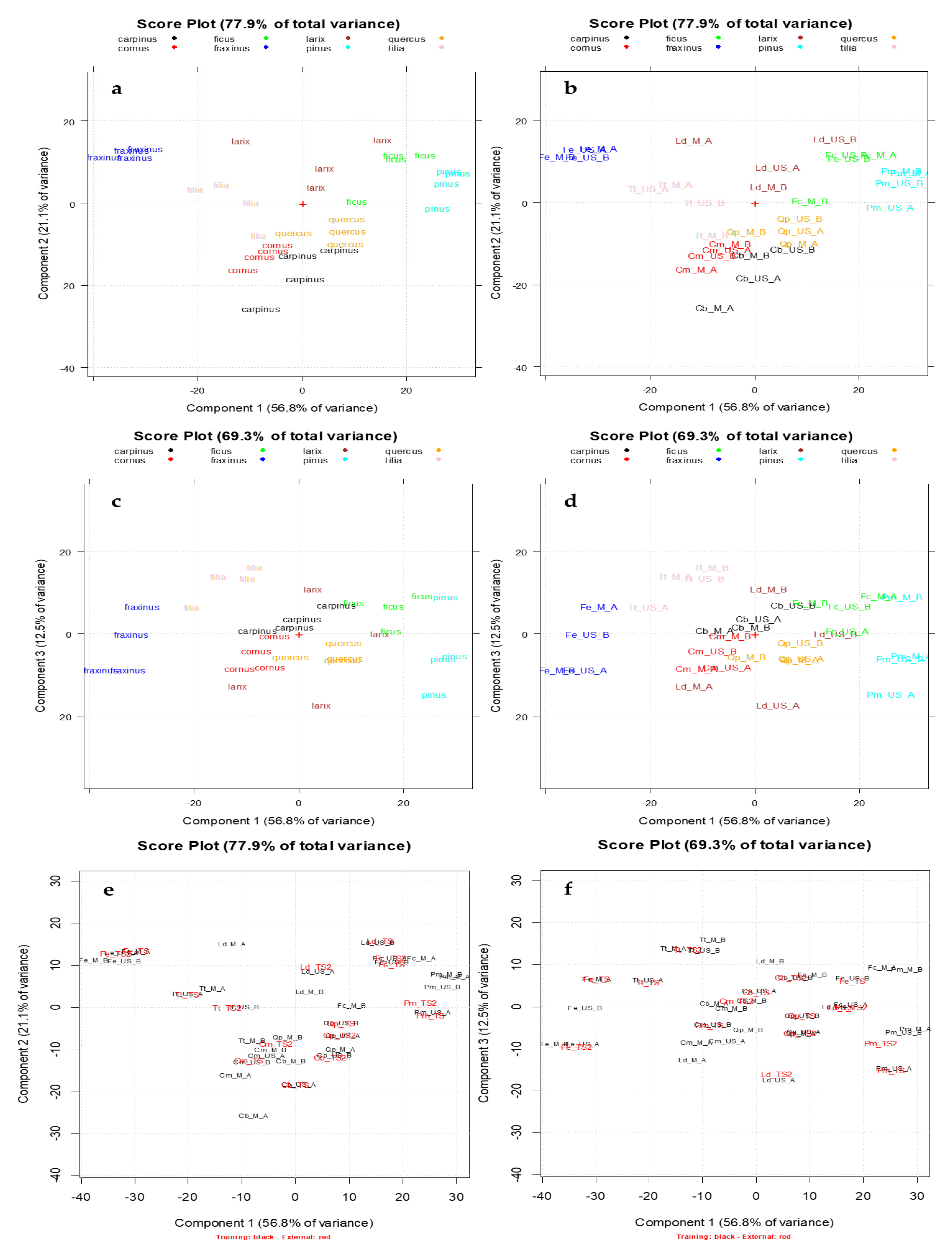
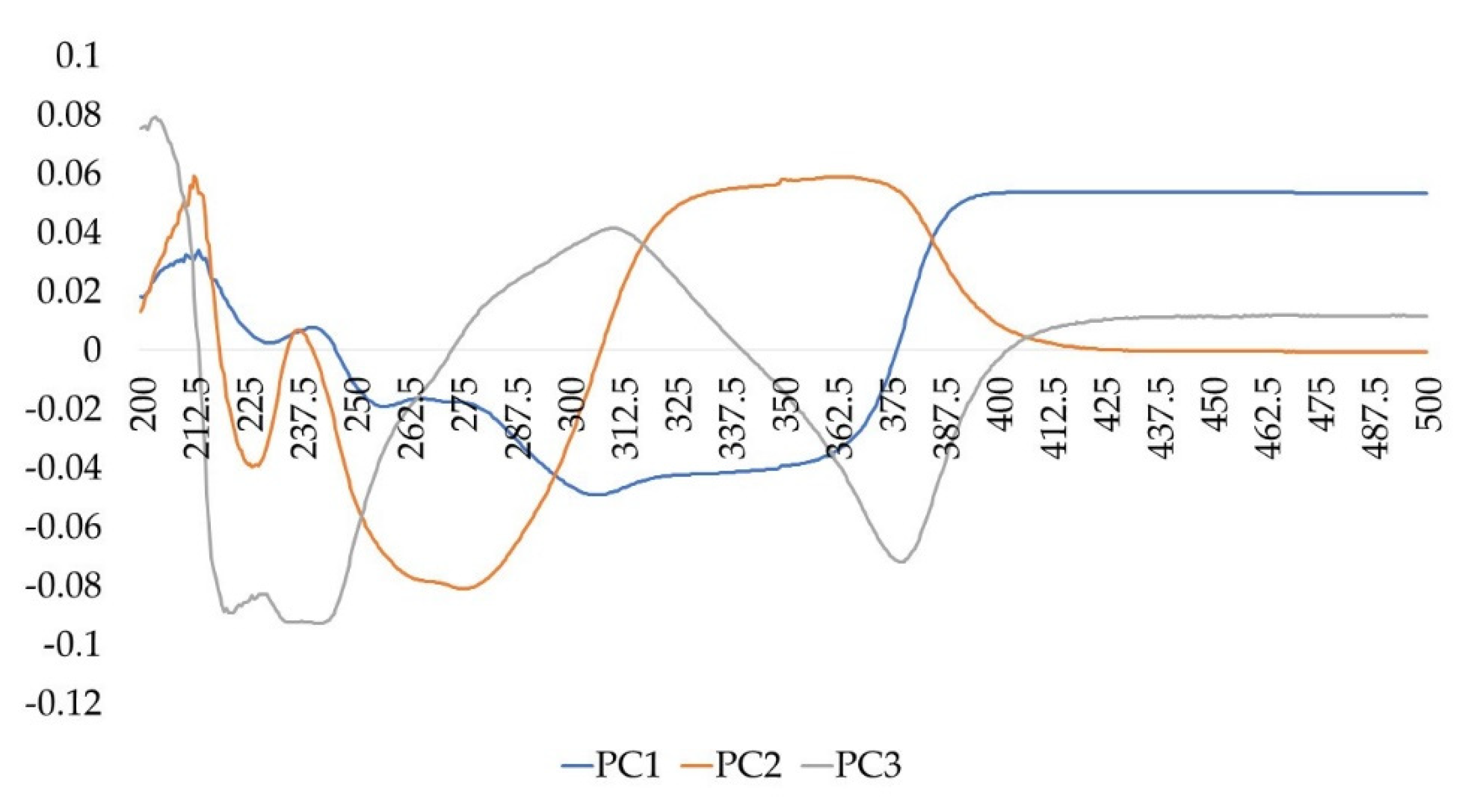
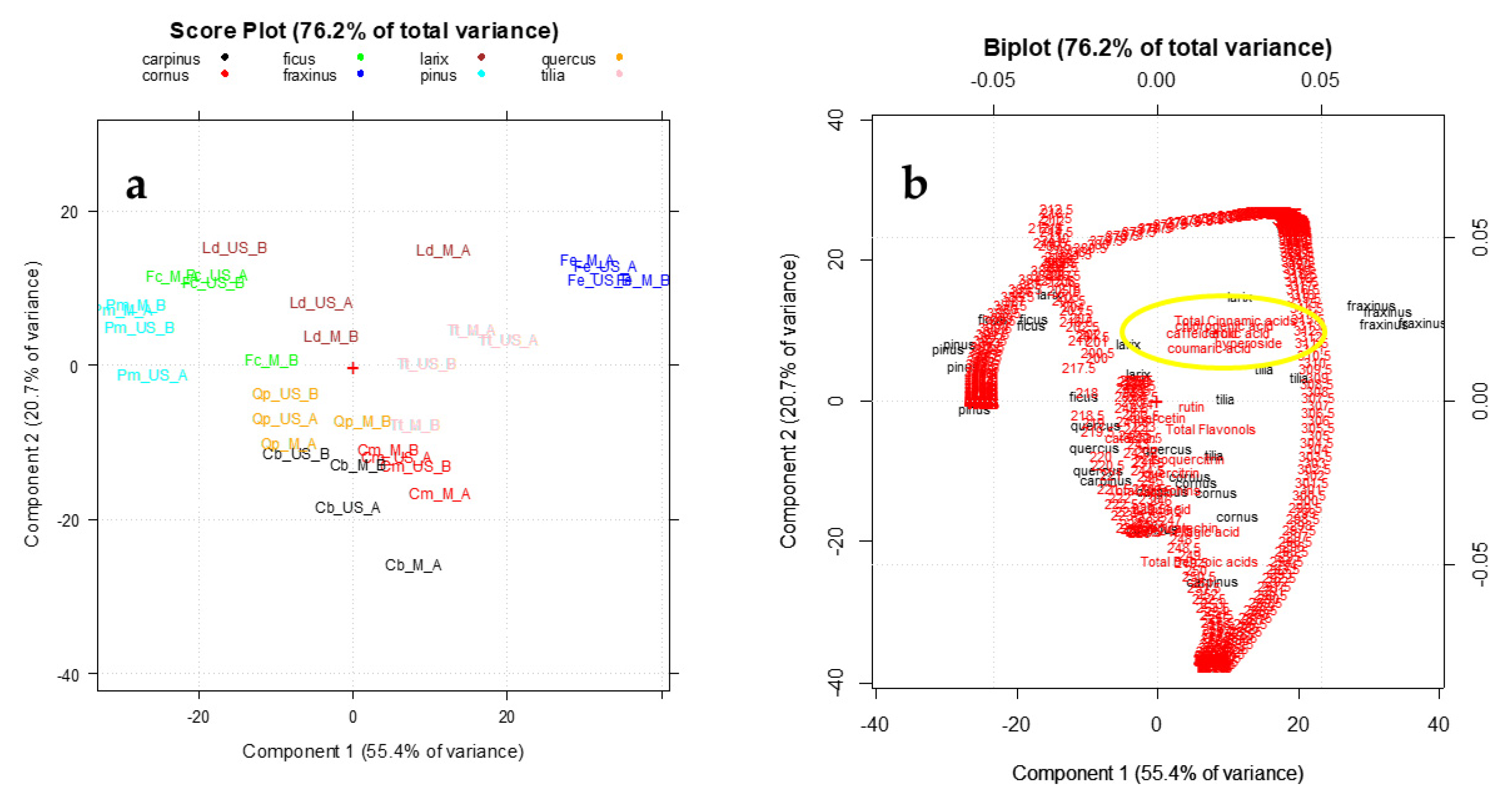

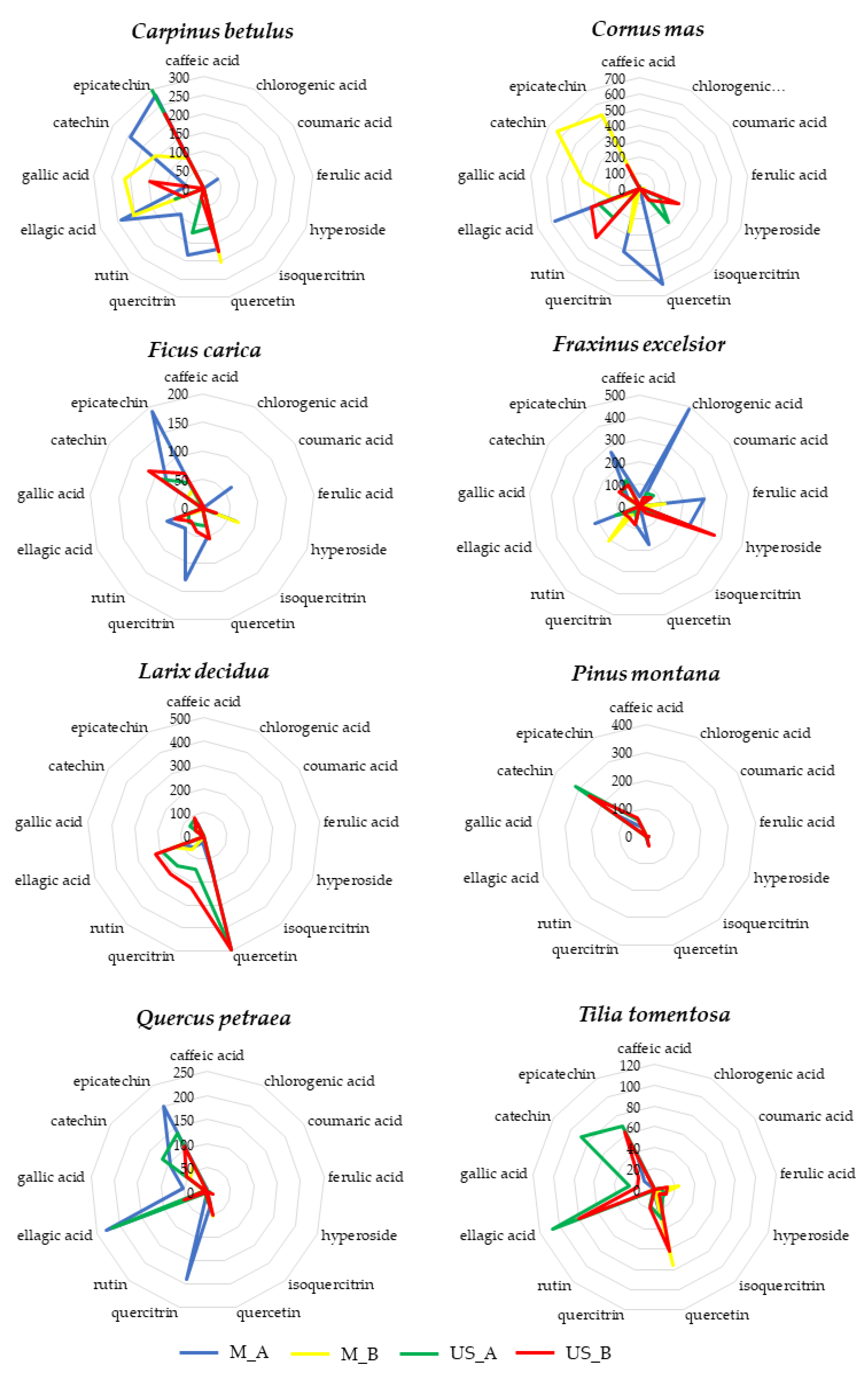
| Vegetable Species | Family (Order) | Collection Site | Geo-Localization Coordinates | Illustrations |
|---|---|---|---|---|
| Carpinus betulus | Betulacee (Fagales) | Bricherasio Prarostino San Germano Rostino | 44.821, 7.285; 44.831, 7.272; 44.825, 7.275 44.913, 7.237 44.868, 7.253 |  |
| Cornus mas | Cornaceae (Cornales) | Bricherasio Torre Pellice Villar Pellice | 44.854, 7.250; 44.855, 7.250; 44.823, 7.307 44.813, 7.181 44.804, 7.154 |  |
| Ficus carica | Moraceae (Rosales) | Brondello Pagno | 44.604, 7.422; 44.603, 7.419; 44.603, 7.418 44.598, 7.424; 44.597, 7.424; 44.598, 7.425 |  |
| Fraxinus excelsior | Oleacee (Lamiales) | Angrogna Bricherasio Massello Paesana Pagno San Germano Chisone | 44.869, 7.173 44.822, 7.284 44.964, 7.031 44.656, 7.261; 44.651, 7.257 44.597, 7.424; 44.598, 7.425; 44.598, 7.424 44.888, 7.261 |  |
| Larix decidua | Pinacee (Pinales) | Praly | 44.902, 7.055 |  |
| Pinus montana | Pinacee (Pinales) | Masello Pramollo | 44.948, 7.065; 44.948, 7.068; 44.947, 7.063 44.918, 7.193 |  |
| Quercus petraea | Fagaceae (Malvales) | Bricherasio | 44.848, 7.275; 44.850, 7.274; 44.842, 7.282; 44.831, 7.270 |  |
| Tilia tomentosa | Malvaceae (Malvales) | Angrogna Bobbio Pellice Bricherasio Perrero | 44.849, 7.223 44.799, 7.131 44.832, 7.265; 44.816, 7.282; 44.821, 7.273; 44.821, 7.285; 44.822, 7.283; 44.818, 7.279 44.936, 7.139 |  |
| Sample Identification Code | Vegetable Species | Extraction Method | Experimental Protocol | Bud/Solvent Ratio | |
|---|---|---|---|---|---|
| 1 | Cb_M_A | Carpinus betulus | M | Protocol A | 1/20 DW |
| 2 | Cb_US_A | Carpinus betulus | US | Protocol A | 1/20 DW |
| 3 | Cb_M_B | Carpinus betulus | M | Protocol B | 1/15 FW |
| 4 | Cb_US_B | Carpinus betulus | US | Protocol B | 1/15 FW |
| 5 | Cm_M_A | Cornus mas | M | Protocol A | 1/20 DW |
| 6 | Cm_US_A | Cornus mas | US | Protocol A | 1/20 DW |
| 7 | Cm_M_B | Cornus mas | M | Protocol B | 1/20 FW |
| 8 | Cm_US_B | Cornus mas | US | Protocol B | 1/20 FW |
| 9 | Fc_M_A | Ficus carica | M | Protocol A | 1/20 DW |
| 10 | Fc _US_A | Ficus carica | US | Protocol A | 1/20 DW |
| 11 | Fc _M_B | Ficus carica | M | Protocol B | 1/10 FW |
| 12 | Fc_US_B | Ficus carica | US | Protocol B | 1/10 FW |
| 13 | Fe_M_A | Fraxinus excelsior | M | Protocol A | 1/20 DW |
| 14 | Fe_US_A | Fraxinus excelsior | US | Protocol A | 1/20 DW |
| 15 | Fe_M_B | Fraxinus excelsior | M | Protocol B | 1/10 FW |
| 16 | Fe_US_B | Fraxinus excelsior | US | Protocol B | 1/10 FW |
| 17 | Ld_M_A | Larix decidua | M | Protocol A | 1/20 DW |
| 18 | Ld_US_A | Larix decidua | US | Protocol A | 1/20 DW |
| 19 | Ld_M_B | Larix decidua | M | Protocol B | 1/20 FW |
| 20 | Ld_US_B | Larix decidua | US | Protocol B | 1/20 FW |
| 21 | Pm_M_A | Pinus montana | M | Protocol A | 1/20 DW |
| 22 | Pm_US_A | Pinus montana | US | Protocol A | 1/20 DW |
| 23 | Pm_M_B | Pinus montana | M | Protocol B | 1/10 FW |
| 24 | Pm_US_B | Pinus montana | US | Protocol B | 1/10 FW |
| 25 | Qp_M_A | Quercus petraea | M | Protocol A | 1/20 DW |
| 26 | Qp_US_B | Quercus petraea | US | Protocol A | 1/20 DW |
| 27 | Qp_M_B | Quercus petraea | M | Protocol B | 1/15 FW |
| 28 | Qp_US_B | Quercus petraea | US | Protocol B | 1/15 FW |
| 29 | Tt_M_A | Tilia tomentosa | M | Protocol A | 1/20 DW |
| 30 | Tt_US_A | Tilia tomentosa | US | Protocol A | 1/20 DW |
| 31 | Tt_M_B | Tilia tomentosa | M | Protocol B | 1/15 FW |
| 32 | Tt_US_B | Tilia tomentosa | US | Protocol B | 1/15 FW |
| Sample Identification Code | Vegetable Species | Extraction Method | Experimental Protocol | |
|---|---|---|---|---|
| 1 | Cb_TS | Carpinus betulus | US | Protocol A |
| 2 | Cb_TS2 | Carpinus betulus | US | Protocol B |
| 3 | Cm_TS | Cornus mas | US | Protocol A |
| 4 | Cm_TS2 | Cornus mas | US | Protocol B |
| 5 | Fc_TS | Ficus carica | US | Protocol A |
| 6 | Fc _TS2 | Ficus carica | US | Protocol B |
| 7 | Fe_TS | Fraxinus excelsior | M | Protocol A |
| 8 | Fe_TS2 | Fraxinus excelsior | US | Protocol A |
| 9 | Ld_TS | Larix decidua | US | Protocol A |
| 10 | Ld_TS2 | Larix decidua | US | Protocol B |
| 11 | Pm_TS | Pinus montana | M | Protocol A |
| 12 | Pm_TS2 | Pinus montana | US | Protocol A |
| 13 | Qp_TS | Quercus petraea | M | Protocol A |
| 14 | Qp_TS2 | Quercus petraea | US | Protocol A |
| 15 | Tt_TS | Tilia tomentosa | US | Protocol A |
| 16 | Tt_TS2 | Tilia tomentosa | US | Protocol B |
| Cinnamic Acids | Flavonols | Benzoic Acids | Catechins | Total Phenolics | ||||||
|---|---|---|---|---|---|---|---|---|---|---|
| Sample ID | Mean Value | SD | Mean Value | SD | Mean Value | SD | Mean Value | SD | Mean Value | SD |
| (mg/100 gFW **) | (mg/100 gFW **) | (mg/100 gFW **) | (mg/100 gFW **) | (mg/100 gFW **) | ||||||
| Tt_M_A | 5.30 | 0.73 | 51.64 | 2.66 | 22.98 | 0.79 | 52.17 | 1.46 | 132.09 | 5.64 |
| Tt_M_B | 23.87 | 1.06 | 90.79 | 5.02 | 6.62 | 1.04 | 50.68 | 1.03 | 171.97 | 8.16 |
| Tt_US_A | 5.33 | 1.39 | 71.26 | 5.92 | 132.56 | 1.68 | 156.46 | 1.78 | 365.61 | 10.77 |
| Tt_US_B | 12.43 | 5.20 | 100.23 | 14.84 | 96.28 | 8.41 | 81.15 | 10.16 | 290.10 | 38.61 |
| Pm_M_A | n.d. | / | 31.13 | 1.45 | n.d. | / | 171.38 | 1.65 | 202.51 | 3.10 |
| Pm_M_B | n.d. | / | n.d. | / | n.d. | / | 49.36 | 2.29 | 49.36 | 2.29 |
| Pm_US_A | n.d. | / | 31.36 | 3.86 | 3.67 | 1.56 | 378.90 | 2.54 | 413.93 | 7.96 |
| Pm_US_B | n.d. | / | 38.74 | 4.35 | n.d. | / | 325.88 | 4.77 | 364.62 | 9.12 |
| Ld_M_A | n.d. | / | 275.15 | 0.91 | 97.07 | 0.31 | 112.09 | 0.67 | 484.31 | 1.88 |
| Ld_M_B | n.d. | / | 151.57 | 2.23 | 137.23 | 0.88 | 70.90 | 2.62 | 359.70 | 5.72 |
| Ld_US_A | 2.40 | 1.02 | 810.86 | 3.32 | 190.25 | 0.95 | 152.12 | 2.12 | 1155.63 | 7.42 |
| Ld_US_B | n.d. | / | 941.62 | 13.22 | 219.28 | 3.66 | 127.08 | 7.33 | 1287.98 | 24.21 |
| Fe_M_A | 829.03 | 2.26 | 499.08 | 2.52 | 214.49 | 0.69 | 328.25 | 1.68 | 1870.85 | 7.15 |
| Fe_M_B | 119.44 | 0.98 | 223.61 | 3.43 | 40.81 | 1.25 | 98.75 | 2.52 | 482.61 | 8.18 |
| Fe_US_A | 151.00 | 2.32 | 378.93 | 4.62 | 115.82 | 0.93 | 225.26 | 2.21 | 871.01 | 10.07 |
| Fe_US_B | 113.53 | 6.70 | 551.07 | 10.06 | 77.40 | 2.30 | 215.96 | 5.28 | 957.96 | 24.34 |
| Cm_M_A | 23.97 | 0.40 | 1055.03 | 1.87 | 577.48 | 0.37 | 104.70 | 0.53 | 1761.19 | 3.18 |
| Cm_M_B | 24.59 | 1.55 | 310.99 | 2.06 | 541.34 | 2.35 | 1161.65 | 2.48 | 2038.58 | 8.45 |
| Cm_US_A | 14.87 | 1.04 | 672.04 | 3.57 | 276.38 | 1.33 | 98.83 | 1.21 | 1062.12 | 7.15 |
| Cm_US_B | n.d. | / | 784.79 | 12.98 | 329.55 | 2.85 | 167.03 | 4.67 | 1281.37 | 20.50 |
| Cb_M_A | 47.04 | 0.83 | 442.45 | 2.04 | 286.40 | 1.25 | 523.93 | 1.14 | 1299.83 | 5.26 |
| Cb_M_B | n.d. | / | 203.20 | 1.18 | 418.85 | 2.56 | 248.73 | 2.73 | 870.78 | 6.47 |
| Cb_US_A | n.d. | / | 230.16 | 2.82 | 80.56 | 1.04 | 297.57 | 1.07 | 608.29 | 4.92 |
| Cb_US_B | n.d. | / | 198.98 | 5.89 | 206.42 | 4.05 | 227.60 | 3.00 | 633.00 | 12.95 |
| Fc_M_A | 62.21 | 0.84 | 287.89 | 4.35 | 67.29 | 0.89 | 267.35 | 2.16 | 684.74 | 8.25 |
| Fc_M_B | n.d. | / | 123.28 | 3.65 | 45.86 | 1.08 | 68.42 | 2.11 | 237.57 | 6.83 |
| Fc_US_A | 6.49 | 2.62 | 116.68 | 4.31 | 26.33 | 1.18 | 138.27 | 2.64 | 287.77 | 10.76 |
| Fc_US_B | 10.77 | 5.54 | 155.02 | 11.39 | 52.18 | 3.49 | 183.91 | 7.34 | 401.88 | 27.76 |
| Qp_M_A | 5.08 | 0.65 | 223.63 | 1.97 | 283.59 | 1.28 | 294.75 | 0.85 | 807.06 | 4.75 |
| Qp_M_B | n.d. | / | 59.40 | 2.75 | 84.02 | 2.16 | 109.81 | 2.18 | 253.23 | 7.09 |
| Qp_US_A | 1.76 | 1.29 | 55.98 | 4.96 | 223.32 | 2.35 | 253.81 | 2.23 | 534.87 | 10.83 |
| Qp_US_B | n.d. | / | 72.09 | 8.50 | 58.43 | 5.70 | 161.81 | 4.89 | 292.32 | 19.08 |
© 2020 by the authors. Licensee MDPI, Basel, Switzerland. This article is an open access article distributed under the terms and conditions of the Creative Commons Attribution (CC BY) license (http://creativecommons.org/licenses/by/4.0/).
Share and Cite
Turrini, F.; Donno, D.; Beccaro, G.L.; Pittaluga, A.; Grilli, M.; Zunin, P.; Boggia, R. Bud-Derivatives, a Novel Source of Polyphenols and How Different Extraction Processes Affect Their Composition. Foods 2020, 9, 1343. https://doi.org/10.3390/foods9101343
Turrini F, Donno D, Beccaro GL, Pittaluga A, Grilli M, Zunin P, Boggia R. Bud-Derivatives, a Novel Source of Polyphenols and How Different Extraction Processes Affect Their Composition. Foods. 2020; 9(10):1343. https://doi.org/10.3390/foods9101343
Chicago/Turabian StyleTurrini, Federica, Dario Donno, Gabriele Loris Beccaro, Anna Pittaluga, Massimo Grilli, Paola Zunin, and Raffaella Boggia. 2020. "Bud-Derivatives, a Novel Source of Polyphenols and How Different Extraction Processes Affect Their Composition" Foods 9, no. 10: 1343. https://doi.org/10.3390/foods9101343
APA StyleTurrini, F., Donno, D., Beccaro, G. L., Pittaluga, A., Grilli, M., Zunin, P., & Boggia, R. (2020). Bud-Derivatives, a Novel Source of Polyphenols and How Different Extraction Processes Affect Their Composition. Foods, 9(10), 1343. https://doi.org/10.3390/foods9101343










